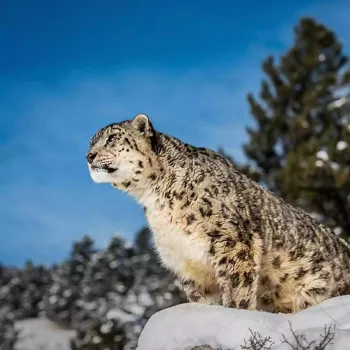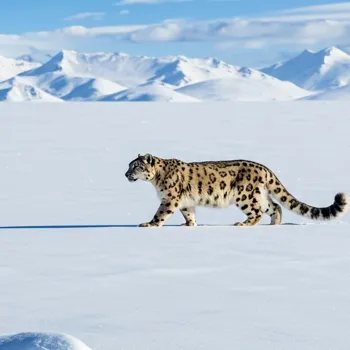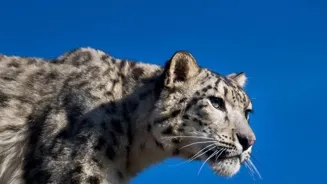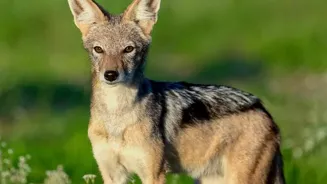Unveiling India's Snow Leopards: Guardians of the Himalayas. Discover 10 intriguing facts about these majestic creatures. Explore more!
India, a land known for its vibrant culture, diverse landscapes, and rich
wildlife, holds a secret within its snow-capped Himalayas – the elusive snow leopard.

These majestic creatures, often called the "ghosts of the mountains," are perfectly adapted to survive in the harsh, high-altitude environment. Their survival is crucial for maintaining the delicate ecological balance of the region. Many people may not know about these important facts about snow leopards:
Snow leopards' camouflage aids survival in their mountain habitat
Snow leopards are incredibly skilled at blending into their surroundings. Their thick, smoky-grey fur is patterned with dark rosettes, acting as a natural camouflage against the rocky, snow-covered terrain.

The fur helps them to disappear almost seamlessly, allowing them to stalk their prey undetected. This camouflage isn't just for hunting. It's also a survival mechanism, helping them to avoid detection by other predators or even humans.
Their ability to disappear into the mountain landscape is one of the reasons why they are so difficult to study and protect. Understanding the role of camouflage in their survival is crucial for developing effective conservation strategies that minimize human disturbance in their natural habitat.
The thick fur is not just about the snow.
Snow leopards' unique adaptations help them thrive in the Himalayas
Snow leopards have evolved remarkable adaptations to thrive in the high altitudes of the Himalayas. They have an unusually large chest capacity and specialized respiratory systems that allow them to extract oxygen more efficiently from the thin air.
Their paws are also uniquely adapted, being large and wide like snowshoes providing excellent grip on steep, icy slopes. This gives them significant advantage over other potential predators, allowing them to navigate areas where other animals struggle.
These adaptations are critical for their survival in an environment where resources are scarce and the conditions are demanding. Their bodies really tell the story of their habitat, this is something to cherish about snow leopards.
Snow leopards lead solitary lives, marking territories for survival
Snow leopards lead a solitary life, only interacting with each other during mating season. Each snow leopard roams within their own territory, which can range from 20 to 1,000 square kilometers, depending on the availability of prey.

Their territories are clearly marked using their scent, claw marks, and scat, which are deposited in strategic locations. This solitary nature makes them particularly susceptible to threats like habitat loss and fragmentation, as they require large areas of undisturbed land.
Understanding their solitary behavior is very important. This is because conservation efforts need to focus on maintaining the integrity of their individual territories.
Snow leopards' survival relies on impressive leaping skills
These creatures are known for their incredible jumping abilities. They can leap distances of up to 50 feet in a single bound. This is due to their powerful hind legs and flexible spine. This remarkable skill has helped them to navigate the rocky terrain and capture their prey.
Imagine them bounding across the landscape with such grace. This leaping ability is key to their survival in steep and challenging environment. Their hunting success relies on their ability. To surprise animals with this skill helps them hunt easily. Seeing a snow leopard leap is something to see.
Snow leopards communicate subtly through vocalizations, scents, and body language for conservation
Snow leopards communicate with each other using a variety of vocalizations, none of which are a true roar. They make sounds like puffs, mews, hisses, and growls. They also use scent marking to communicate their presence and territory boundaries.
Visual signals, such as tail movements and body postures, which are important. While information is valuable for understanding the species. Their communication is subtle and secretive, mirroring their elusive nature. Conservationists are actively researching these cues.
To know what their needs are is helping preserve their needs. Protecting them from threats is important.
Conserving snow leopards in India faces multiple threats; habitat loss, poaching, climate change
The conservation of snow leopards in India faces numerous challenges. Habitat loss due to infrastructure development and grazing is a major threat. Poaching for their fur and bones, along with retaliatory killings by farmers who lose livestock, pose other significant risks.
Climate change is further compounding these challenges. It is altering the snow patterns and impacting prey availability. Conservation organizations and the Indian government are working together.
The goal is to implement anti poaching measures, promote community based conservation programs, and research and monitor snow leopard populations. Securing their future requires a multi-faceted approach that addresses both the direct threats and other challenges.
Estimating India's elusive snow leopard population, crucial for conservation planning
Determining the exact number of snow leopards in India is difficult due to their elusive nature and the rugged terrain they inhabit. However, it is estimated the number is between 400 and 700 individuals scattered across the high altitude regions.
The states of Jammu and Kashmir, Himachal Pradesh, Uttarakhand, Sikkim, and Arunachal Pradesh serve as important strongholds for the species. The Indian government has launched the Snow Leopard Population Assessment of India (SPAI) project.
In order to conduct a systematic estimation of snow leopard numbers across their entire range. This information is essential for informed conservation planning.
Snow leopards crucial for Himalayan ecosystem balance
As apex predators, snow leopards play a vital role in maintaining the ecological balance of the Himalayan environment. They primarily prey on ungulates like ibex, blue sheep, and argali. By controlling the populations of these herbivores, they prevent overgrazing.
This helps maintain the health of the alpine meadows and grasslands. Their presence is an indicator of a healthy ecosystem. If snow leopards are thriving, it suggests that the entire food chain below them is also functioning well.
Conserving snow leopards is a means of protecting the entire Himalayan ecosystem.
Cultural significance of snow leopards in Himalayan region
Snow leopards hold cultural significance for many communities that live in the Himalayan region. For some, they represent strength, resilience, and the untamed spirit of the mountains. They feature in local folklore and traditions, often viewed with respect and reverence.
In some communities they are considered sacred animals. This deep cultural connection can be leveraged for conservation efforts. By engaging local communities in protecting snow leopards, conservationists can create a sense of shared responsibility and ensure the long term survival of the species.
Hope for snow leopards in India with conservation efforts
Despite the challenges, there is hope for the future of snow leopards in India. Conservation efforts are gaining momentum with increased awareness and collaboration among government agencies, conservation organizations and local communities.
Innovative technologies like camera trapping and GPS collaring are being used to study snow leopard behavior and track their movements. This information helps is helping to inform targeted conservation strategies.
By continuing to prioritize snow leopard conservation, India can ensure that these magnificent animals continue to roam the Himalayas for generations to come.
Facts about India's snow leopards, urging conservation efforts
These are just a few of the amazing facts about India's snow leopards. These elusive guardians of the Himalayas. By learning more about them. We can better understand and appreciate their importance and work together to ensure their survival.
Their future remains in our hands, demanding our committed action to safeguard their homes. Every effort we make to conserve these is helpful.













